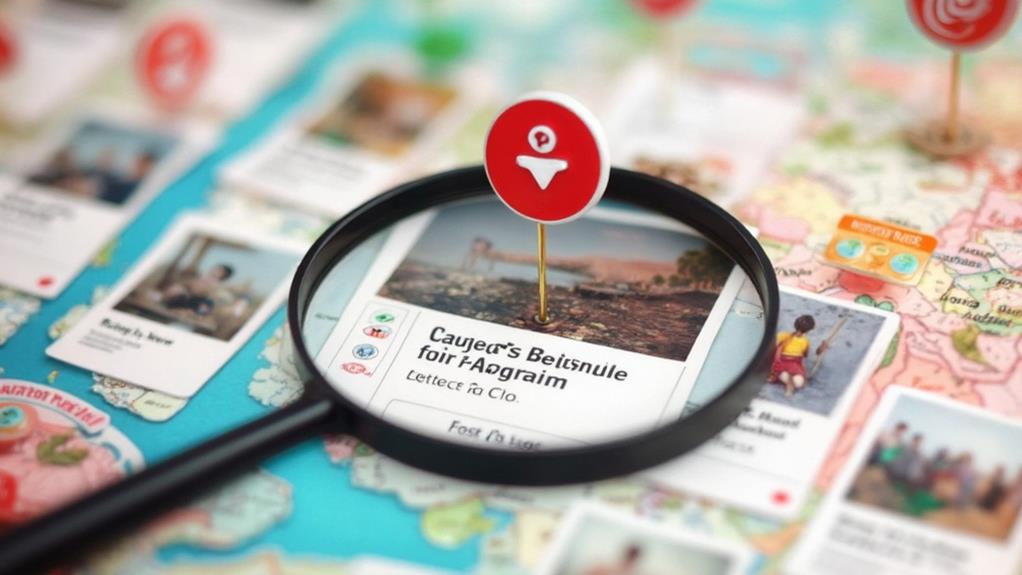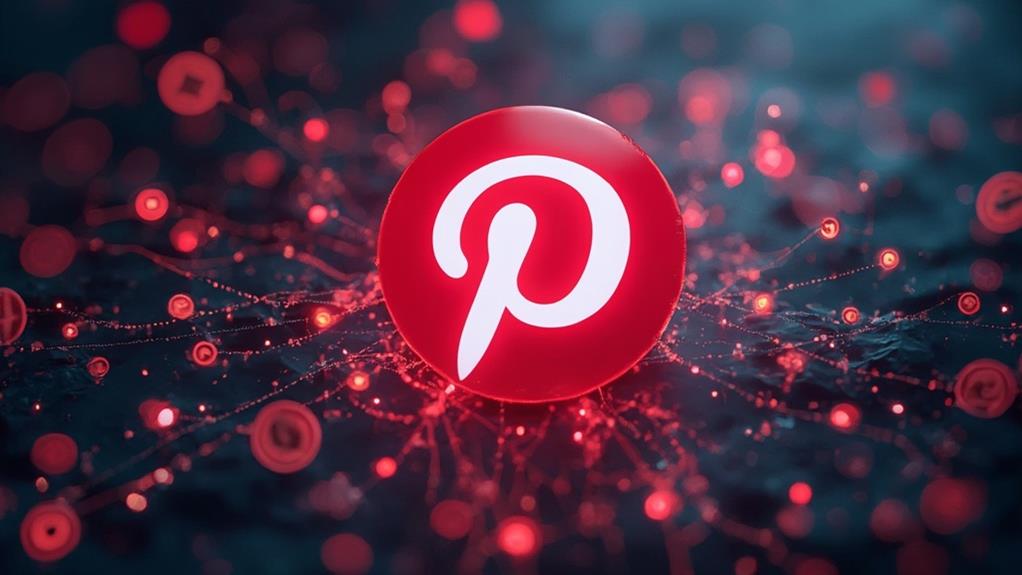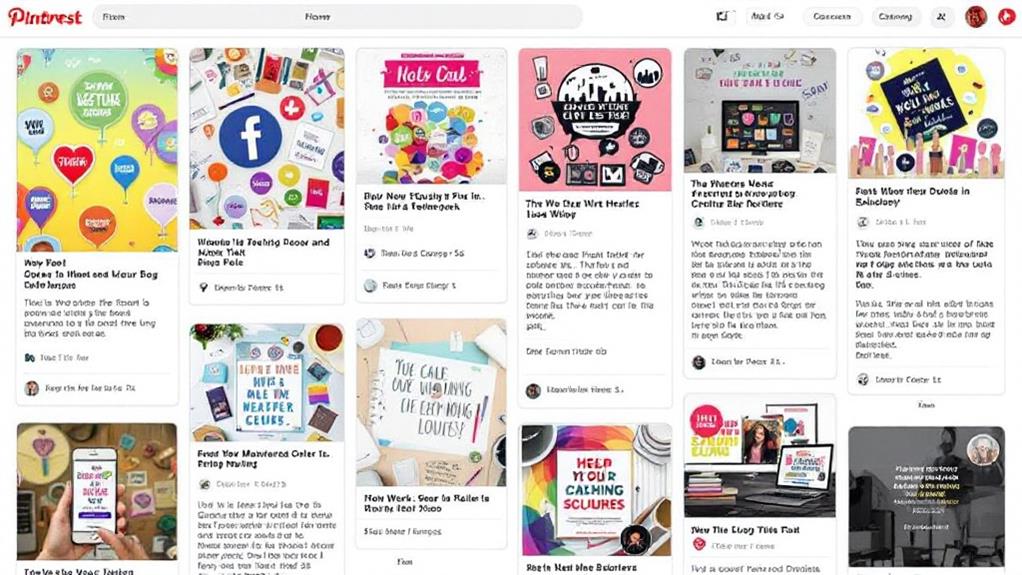Pinterest Rich Pins are a powerful tool for bloggers to enhance their content's visibility and engagement on the platform. They provide additional context by displaying extra information directly on the pin, such as article headlines, author names, and descriptions. By implementing Rich Pins, you'll boost your blog's credibility, improve search visibility, and potentially increase click-through rates. There are four types of Rich Pins: Article, Product, Recipe, and App, each offering unique benefits for different content niches. Setting up Rich Pins involves adding specific metadata to your website and getting approval from Pinterest. Dive deeper to reveal the full potential of this feature for your blog's success.
What Are Rich Pins?

Understanding Rich Pins is essential for any Pinterest user looking to enhance their content's visibility and appeal. Rich Pins are an advanced type of pin that provide more context about your content directly on the pin itself. They're designed to give users a richer, more informative experience when browsing Pinterest, which can lead to increased engagement and traffic to your website.
There are four types of Rich Pins: Article, Product, Recipe, and App. Each type includes specific metadata that's relevant to its category. For example, Article Rich Pins display the headline, author, and description of the article, while Product Rich Pins show real-time pricing, availability, and where to buy the item.
To use Rich Pins, you'll need to add metadata to your website's pages and apply for Rich Pins through Pinterest. Once approved, Pinterest will automatically pull this information to create Rich Pins whenever someone saves content from your site. This process guarantees that your pins always contain up-to-date information.
Rich Pins offer several benefits for content creators and businesses. They stand out in users' feeds, providing more valuable information at a glance. This increased visibility can lead to higher click-through rates and more repins. Additionally, Rich Pins can help establish your credibility and authority in your niche by showcasing your expertise and offering detailed information about your content or products.
Types of Rich Pins
Pinterest offers four distinct types of Rich Pins, each designed to showcase specific content in the most effective way. These types are Article, Product, Recipe, and App Rich Pins. Each type provides unique information to enhance user experience and drive engagement.
Article Rich Pins are ideal for bloggers and content creators. They display the article's headline, author, and a brief description. When you use these pins, you'll give users a preview of your content, encouraging them to click through to your blog.
Product Rich Pins are perfect for e-commerce businesses. They show real-time pricing, availability, and where to buy the item. If you're selling products, these pins can help drive sales by providing up-to-date information to potential customers.
Recipe Rich Pins are a must for food bloggers and chefs. They include ingredients, cooking times, and serving information. By using these pins, you'll make it easier for users to find and save your recipes, increasing the likelihood of them trying your dishes.
App Rich Pins are designed for mobile app developers. They show an install button, app rating, and price. If you're promoting an app, these pins can help increase downloads by providing essential information upfront.
To use Rich Pins, you'll need to apply for them through Pinterest and add metadata to your website. Once approved, your pins will automatically display the additional information. By choosing the right type of Rich Pin for your content, you'll improve your Pinterest strategy and potentially increase traffic to your site or boost sales.
Benefits for Bloggers

Harnessing the power of Rich Pins can greatly enhance a blogger's presence on Pinterest. As a blogger, you'll find that implementing Rich Pins for your blog posts offers numerous advantages that can notably impact your traffic and engagement.
First, Rich Pins provide more context to your pins, making them more informative and appealing to users. This increased information can lead to higher click-through rates, as users are more likely to engage with pins that offer clear, detailed information about the content they'll find when they click.
You'll also benefit from improved visibility in Pinterest's search results. Rich Pins are given preference in the platform's algorithm, meaning your content is more likely to appear in relevant searches and recommended pins. This increased visibility can lead to more followers and a wider reach for your blog.
Another key advantage is the automatic updating feature of Rich Pins. When you make changes to your blog post's title or metadata, the corresponding Rich Pin will update automatically. This guarantees that your pins always display the most current and accurate information, saving you time and effort in manually updating your pins.
Rich Pins also lend credibility to your content. The additional information and metadata associated with Rich Pins signal to users that your content is from a reputable source. This can help build trust with your audience and establish you as an authority in your niche.
Lastly, Rich Pins can improve your Pinterest analytics. You'll gain access to more detailed insights about how users interact with your pins, allowing you to refine your Pinterest strategy and create more effective content.
Setting Up Rich Pins
In light of the numerous benefits Rich Pins offer, setting them up for your blog is an essential step. The process involves a few key stages, beginning with confirming your website has the necessary metadata. You'll need to add either Open Graph or Schema.org markup to your blog posts, which provides Pinterest with the required information to create Rich Pins.
Once you've added the metadata, you'll need to validate and apply for Rich Pins. Visit the Rich Pins Validator tool on Pinterest's developer site and enter the URL of a blog post that includes the metadata. The tool will analyze your page and show you a preview of how your Rich Pin will appear. If everything looks correct, you can then apply for Rich Pins for your entire domain.
After submitting your application, Pinterest will review it, which typically takes a few days. Once approved, all of your blog posts with the proper metadata will automatically become Rich Pins. It's significant to remember that you only need to apply once for your entire website, not for each individual post.
To confirm your Rich Pins are working correctly, create a new pin using a URL from your blog. If the pin displays additional information like your blog title and description, you've successfully set up Rich Pins. Remember to consistently use metadata on all your blog posts to take full advantage of Rich Pins' benefits. If you make any significant changes to your website's structure or metadata, you may need to revalidate your Rich Pins to confirm they continue functioning properly.
Optimizing Blog Posts for Pinterest

Numerous strategies can help you optimize your blog posts for Pinterest and maximize the potential of Rich Pins. First, verify your blog post titles are clear, descriptive, and include relevant keywords. This helps Pinterest users quickly understand what your content is about and improves searchability.
Create high-quality, vertical images for your blog posts. Pinterest favors images with a 2:3 aspect ratio (600×900 pixels). Use eye-catching visuals, bold text overlays, and your brand colors to make your pins stand out in users' feeds.
Incorporate multiple pinnable images throughout your blog post. This gives readers more options to share and increases the likelihood of your content being pinned. Use alt text for your images, including relevant keywords to improve SEO and accessibility.
Write compelling, keyword-rich descriptions for your blog post. These descriptions will be pulled into your Rich Pins, so make them informative and enticing. Include a clear call-to-action to encourage users to click through to your blog.
Implement social sharing buttons on your blog, making it easy for readers to pin your content directly from your site. Place these buttons in prominent locations, such as near images or at the end of your post.
Use hashtags strategically in your pin descriptions. Research popular, relevant hashtags in your niche and include them to increase discoverability.
Rich Pin Best Practices
To maximize the impact of your Rich Pins on Pinterest, you'll want to follow these key best practices. First, verify your website is properly set up for Rich Pins by adding the necessary meta tags or using a WordPress plugin like Yoast SEO. Once approved, consistently use Rich Pins for all your content to maintain a cohesive presence on the platform.
Choose high-quality, vertical images with a 2:3 aspect ratio (600×900 pixels) for ideal visibility in Pinterest's feed. Include your logo or branding elements subtly within the image to increase brand recognition. Craft compelling, keyword-rich titles and descriptions that accurately represent your content while enticing users to click through.
Keep your Rich Pin information up-to-date, especially for product pins where prices and availability may change. Regularly check your pins to verify all links are functional and lead to the correct pages on your website. Utilize Rich Pins across various content types, including articles, recipes, and products, to provide a diverse and engaging experience for your followers.
Implement a consistent pinning schedule to maintain visibility and engagement. Use Pinterest's analytics to track the performance of your Rich Pins and adjust your strategy accordingly. Experiment with different image styles, text overlays, and color schemes to determine what resonates best with your audience.
Collaborate with other Pinterest users in your niche to cross-promote content and expand your reach. Encourage your website visitors to save your Rich Pins by adding "Pin It" buttons to your blog posts and product pages. By following these best practices, you'll maximize the potential of your Rich Pins and drive more targeted traffic to your website.
Measuring Rich Pin Performance

Measuring the performance of your Rich Pins is essential for optimizing your Pinterest strategy. To effectively track your Rich Pins' impact, you'll need to utilize Pinterest Analytics and other measurement tools. Start by ensuring you've claimed your website on Pinterest and enabled Rich Pins. This allows you to access detailed analytics for your pins.
In Pinterest Analytics, focus on metrics like impressions, saves, and click-throughs for your Rich Pins. Compare these to your regular pins to gauge the effectiveness of your Rich Pin content. Pay attention to engagement rates, which indicate how well your Rich Pins resonate with your audience.
Use UTM parameters in your pin URLs to track traffic from Pinterest in Google Analytics. This helps you understand how Rich Pins contribute to your overall website traffic and conversions. Monitor the time users spend on your site after clicking a Rich Pin, as well as their subsequent actions.
Track your Rich Pins' performance over time to identify trends and patterns. Look for correlations between specific types of Rich Pin content and higher engagement or conversion rates. Use this data to refine your Pinterest strategy and create more of the content that performs well.
Don't forget to analyze your competitors' Rich Pins. Observe which of their pins perform best and consider how you can adapt successful strategies to your own content. Regularly review and adjust your Rich Pin approach based on these insights to continually improve your Pinterest performance.
Troubleshooting Common Issues
Several common issues can arise when implementing Rich Pins on Pinterest. If you're experiencing problems, start by checking your website's metadata. Ascertain that you've correctly added the necessary Open Graph tags or JSON-LD markup to your blog posts. These tags should include essential information like the article title, description, and featured image.
If your Rich Pins aren't appearing, verify that you've successfully applied for and been approved for Rich Pins. Sometimes, the approval process can take a few days. Once approved, it may take up to 24 hours for your pins to be updated with rich data.
Another common issue is outdated or incorrect information displayed in your Rich Pins. To resolve this, you can use Pinterest's Rich Pin Validator tool to force a refresh of your pin's data. Simply enter the URL of your blog post, and Pinterest will fetch the latest information.
If you're seeing error messages or your Rich Pins aren't formatting correctly, double-check your HTML structure. Ascertain that your Open Graph tags are placed within the
section of your web page and that there are no conflicting tags or duplicate information.For those using WordPress, plugin conflicts can sometimes interfere with Rich Pin functionality. Try temporarily deactivating other plugins to identify if there's a conflict. Additionally, make sure your chosen Rich Pin plugin is up to date and compatible with your current WordPress version.
If you've implemented schema markup instead of Open Graph tags, verify that your schema is correctly formatted and includes all required properties for article Rich Pins.
Future of Rich Pins

While troubleshooting can help resolve current issues, it's important to look ahead at what's in store for Rich Pins. Pinterest continually evolves its features to enhance user experience and provide more value to content creators. In the future, you can expect Rich Pins to become even more sophisticated and offer greater customization options.
One potential development is the integration of artificial intelligence to automatically generate Rich Pin content based on your blog post. This could save you time and guarantee your pins are optimized for maximum engagement. Another possibility is the introduction of interactive elements within Rich Pins, allowing users to engage with your content directly on Pinterest before clicking through to your site.
You might also see expanded Rich Pin types, catering to more specific niches and content formats. This could include specialized pins for recipes, product reviews, or educational content, each with unique features tailored to their purpose. Additionally, Pinterest may introduce more robust analytics for Rich Pins, giving you deeper insights into how users interact with your content on the platform.
As mobile usage continues to grow, expect Rich Pins to become more mobile-friendly, with improved loading times and responsive designs. Pinterest may also enhance its integration with other platforms, making it easier to share your Rich Pins across multiple social media channels.
To stay ahead of these changes, keep an eye on Pinterest's official announcements and regularly update your Rich Pin implementation. By embracing new features and adapting your strategy, you'll guarantee your content remains engaging and effective on the platform.

Erzsebet Frey (Eli Frey) is an ecologist and online entrepreneur with a Master of Science in Ecology from the University of Belgrade. Originally from Serbia, she has lived in Sri Lanka since 2017. Eli has worked internationally in countries like Oman, Brazil, Germany, and Sri Lanka. In 2018, she expanded into SEO and blogging, completing courses from UC Davis and Edinburgh. Besides Litepreneur, Eli has founded multiple websites focused on biology, ecology, environmental science, sustainable and simple living, and outdoor activities. She enjoys creating nature and simple living videos on YouTube and participates in speleology, diving, and hiking.

